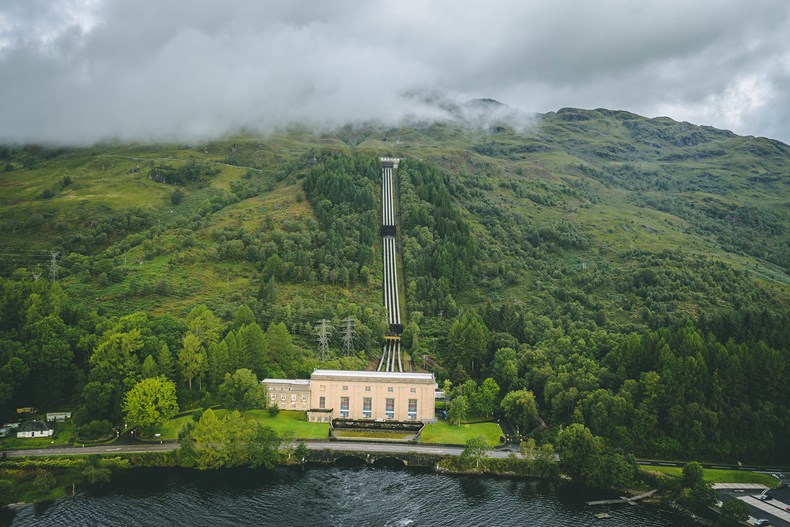
Sloy Power Station, on the banks of Loch Lomond was the first hydro scheme to be developed under the North of Scotland Hydro-Electric Board and this week it celebrates 70 years of power generation!
As an operational building it’s not easy to open our doors for celebrations in the current climate, however we do want as many people as possible to join in the celebration so please accept a warm welcome via this special anniversary blog.
Welcome to Sloy Power Station
Sloy is the largest conventional hydro-electric power station in the UK. It has an installed capacity of 152.5 MW generating enough electricity to power over 80,000 homes. It can operate at full load within five minutes of a standing start and it is this almost instant availability that makes it ideal for use during times of peak demand.
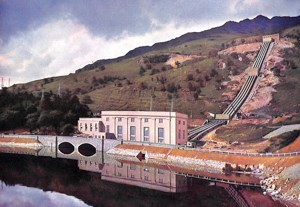 | 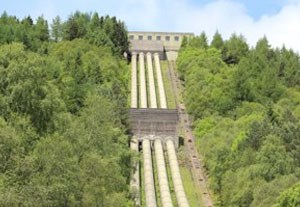 | 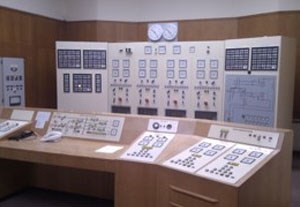 |
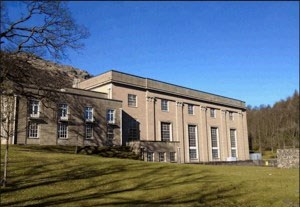 | 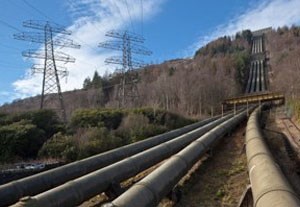 | 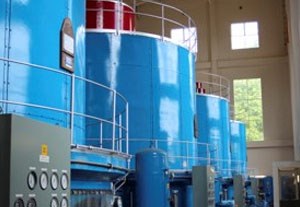 |
Where it all began
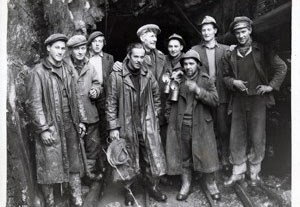 | 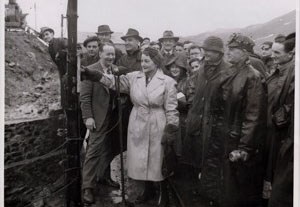 |
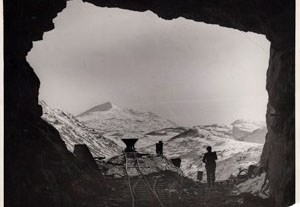 | 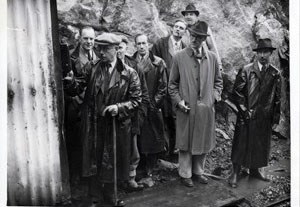 |
Photos credited to: Leddy & Glen, Alexandria (1949)
The North of Scotland Hydro Electric Board (NOSHEB) was established by an Act of Parliament in 1943 and was responsible for generating, transmitting, distributing and supplying electricity throughout the north of Scotland, including the Highlands and Islands. NOSHEB’s purpose was to develop abundant cheap electricity for the people living in the north of Scotland whilst attracting new industries to the area and the export of surplus power to consumers in the south. The profit from this sale of surplus power was used to subsidise the costs of distributing power to the more remote areas of the Highlands and would be used to support economic development and social improvement in the north of Scotland. The region, which covers an area of 21,750 square miles, contains Britain’s highest mountains and largest inland lochs combined with high rainfall levels making ideal conditions for hydro generation.
Sloy was the first scheme to be built following the Act of Parliament. Driven forward by the then Secretary of State for Scotland, Tom Johnston, the first sod was cut on 11 June 1945 by his wife, not with the usual polished spade, but an 18 tonne bulldozer. The sod cut was a strip of turf about 12 feet wide and 100 feet long, an act that was acknowledged later as a ‘fitting prelude to a big job”.
An outstanding engineering feat but at great human cost
The completed works at Sloy are a permanent reminder of the skill, experience and labour from all parts of Britain, Ireland and across Europe had a share in their design, construction and equipment. Over the course of five years of construction the ebb and flow of labour provided employment to over 2,200 workers: building roads; excavating foundations; pouring concrete; driving tunnels and installing machinery and equipment.
The work was gruelling, the environment was tough and so it was no surprise that accidents happened and worse, fatalities were caused. Twenty-one workers lost their lives during the construction of Sloy and the lives of these men continue to be remembered on a commemorative plaque which hangs in the entrance stairwell of the station building.
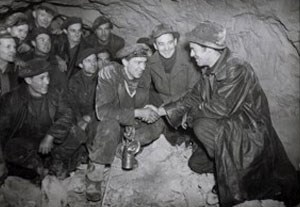 | 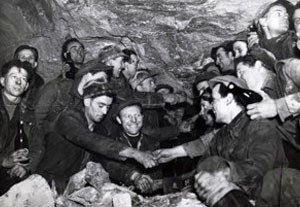 |
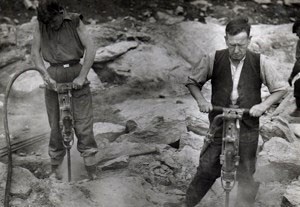 | 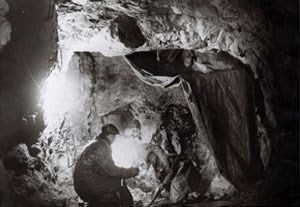 |
Photos credited to: Leddy & Glen, Alexandria (1949)
How it works
Nestled on the western shores of picturesque Loch Lomond, perhaps Scotland’s most famous loch, and gazing up past Sloy Power Station to the four huge pipes that feed its turbines, it is hard to imagine that Glasgow is less than 30 kilometres to the south east.
The power station is fed from Loch Sloy, just four kilometres away but, crucially, over 277 metres higher than the power station. This huge difference in height within a short horizontal distance is what provides the power to produce an annual average of over 120 million units of electricity – that’s about one million units for every inch of rainfall in its catchment area.
Loch Sloy is contained by Sloy Dam which, at 357 metres long and 56 metres high, attracts from areas to the north and south via a system of tunnels and aqueducts.
The dam was the first of 9 buttress dams to be constructed for the North of Scotland Hydro-Electric Board, this being the first of 4 which were designed by James Williamson and Partners.
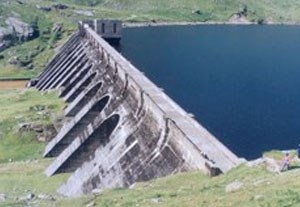 | 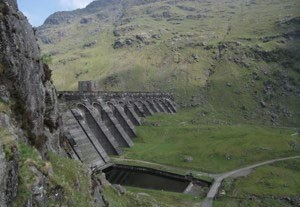 | 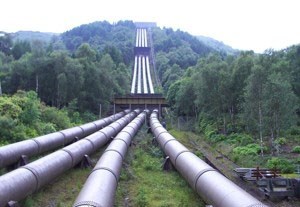 |
A 3 km tunnel carries water from Loch Sloy through Ben Vorlich, to the valve house immediately above the Power Station. From here the water plunges down the side of the mountain through its four large pipelines and into the power station where four turbines drive four vertical shaft generating sets – 3 rated at 40MW and one at 32.5MW totalling 152.5MW. each developing 32.5MW. There is also a 450kW Pelton wheel generator for emergency supplies.
When brought into service at times of peak demand – Sloy Power station can operate at full load within five minutes from a standing start.
With an installed capacity of 152.5MW Sloy has the largest capacity of Hydro-Electric's conventional hydro stations and when the four machines are running at full load nearly a million gallons of water pass through every minute.
Built to last
The remote and inhospitable terrain, combined with the heavy rainfall and snowfall that made the area so ideally suited for hydro-electric development, made the construction of this scheme extremely challenging. Miles of access roads had to be built and work was frequently halted by poor weather as this insert from the official Sloy Commemoration booklet describes:
"The snow blizzards and the rain beat down on the rocky hillsides often for days on end, 106 inches in 1947, 168 inches in 1947 and 156 inches in 1949. The records show 230 wet days in a year. In one month alone, the rainfall was 26.5 inches, which is more than the average rainfall for a year in Dundee, Edinburgh or Birmingham! The weather was aptly described by an American journalist who, after visiting the scheme, wrote – Loch Sloy, where the rain falls horizontally ..."
Sloy Commemoration booklet
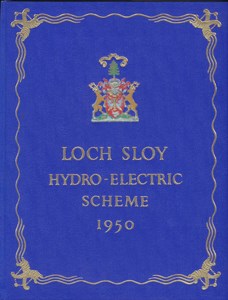 |  |
It didn’t take long for Scotland’s post war industries to realise the opportunities that existed by diverting traditional skills to manufacture pipelines, generating machinery and other essential materials. From Ayrshire came the valves and gates to control the dam and Aberdeen contributed the granite for the power station facings. Women also had a share in the tasks, with young women in a Clydeside engineering shop being employed to complete the alternators and, more locally, others found jobs in the canteens and in the wooden huts that served as offices.
By mid-summer in 1945 the road from Loch Lomond into the hills was being constructed. The first of four camps to house the workers was built and a diesel generating station, two new railway stations and a railway bridge were completed by the end of the year. Momentum remained throughout the following years with 15 miles of access roads being built as well as tunnels, dam, pipelines and the power station.
In the hills isolated gangs were driving smaller tunnels and aqueducts with one crew driving through 221 feet of rock in a week – a world record at the time!
The main tunnel was driven through in April 1949, the first diversion tunnel was completed later in October and the first turbo-alternator began to produce electricity in March 1950.
However, long before the machinery was in place, nearby villages of Tarbet and Arrochar were being supplied with electricity from the Loch Sloy scheme diesel station.
 | 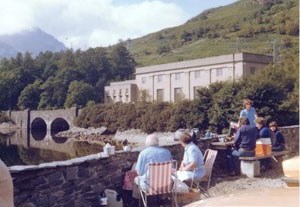 | 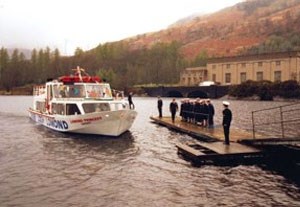 |
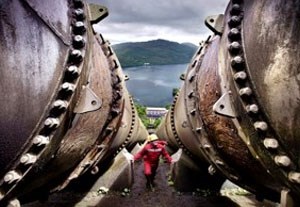 | 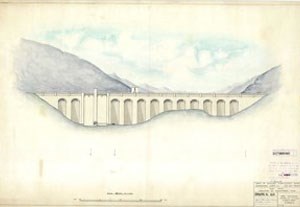 | 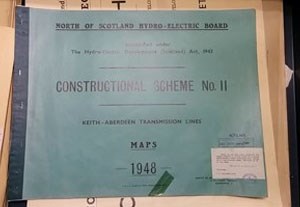 |
The grand opening
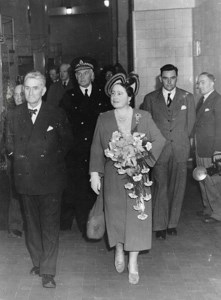 | 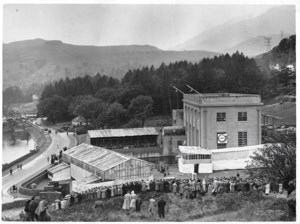 |
The power station was commissioned on the 18th October in 1950 with the initial welcome speech given by Tom Johnston. He said: ‘Here at Loch Lomond Side, in the most besung area in the world, our engineers, contractors, and workmen, have performed marvellous feats of skill and endurance.’ For the full speech click here.
Part of Queen Elizabeth The Queen Mother’s speech has been archived and made available on YouTube by British Pathe. She said: ‘Everyone will I know join with me in expressing the warmest admiration of those whose vision, tonacity and technical skill have welded together in facing and conquering so formidable a task’
The archived newspaper cuttings from the event have been digitised and can been viewed at the links below.
Article
2000 see Queen open Loch Sloy scheme
Pictures
The Queen and Tom Johnston leaving generating station
The Queen walking round station with Tom Johnston
The Queen pulling lever to bring the turbo-generators into action.
Leaving a legacy …
With Sloy proving to be a resounding success, the Board began further plans to develop the scheme, taking a further two decades to complete the Sloy / Awe hydro scheme as we know it today.
The power station and associated structures, including the four pipelines, have been listed by Historic Scotland in recognition of the bold, classical, modernist design of the station which was designed by architects Tarbolton and Ochterlony.
But probably most striking of all is that this outstanding engineering project, dating as far back as World War 2, continues to make a hugely important contribution today generating over 8.5 billion units (kWh) to date. The quick reaction times of the generator mean it has an even more important role to play by providing flexible power when the wind is not blowing and helping in our fight against climate change.


